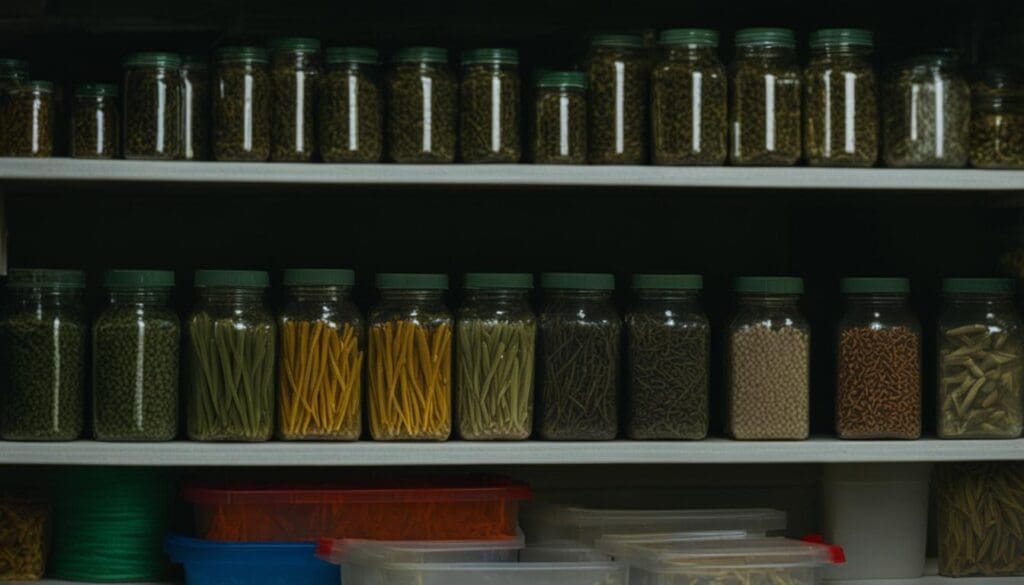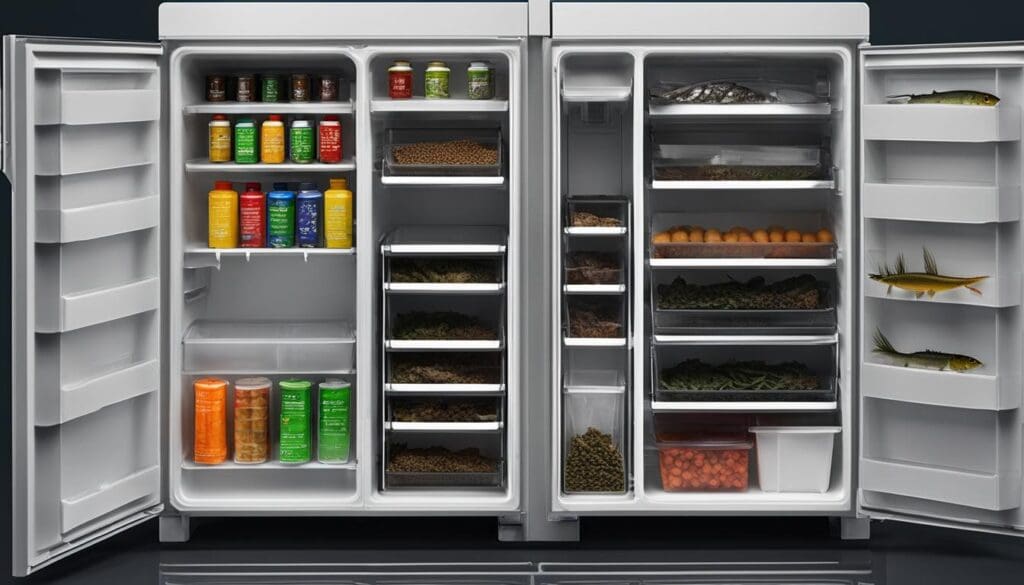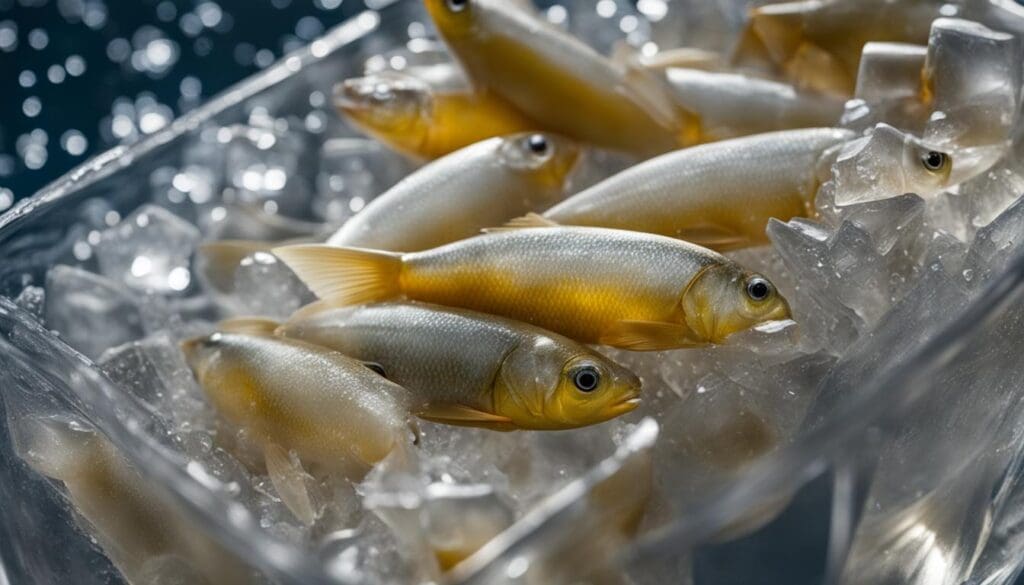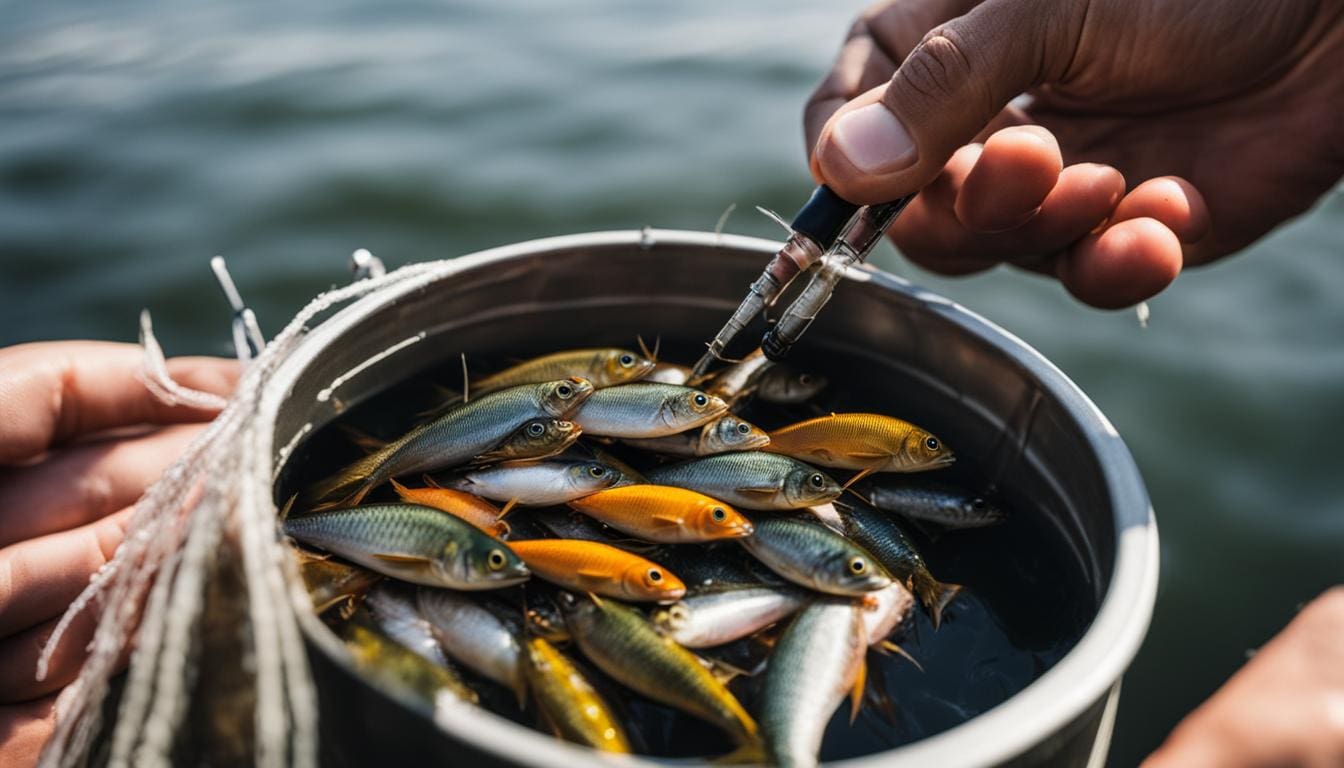The allure of live baits in the hands of an adept angler is not just a matter of skill but a testament to the rigorous care and preservation techniques that sustain these natural lures. An essential factor in the enigmatic dance between predator and prey is the fidelity of live baits—ensuring their natural scent and lifelike motion remain as enticing in the water as in their native habits. Utilizing proven live baits storage methods and fresh bait preservation techniques is critical to maintaining bait quality. To effectively extend the life of your fresh bait, professional guide Jim Duckworth advises an equilibrium of temperature and oxygen levels within your bait storage system.
Preserving live baits hinges upon creating conditions that mimic their natural environment, thereby extending bait life and maximizing efficacy during those pivotal fishing moments. From the innovative bait storage techniques promoted by seasoned anglers to the dedication to detail involved in effective live bait storage, the art of maintaining bait quality is multifaceted. Fueling these efforts is the indispensable knowledge of the physiological needs of your piscine allies—the faint heartbeat of your next big catch.
Key Takeaways
- Mastering live baits storage is essential for retaining the enticing scent and action that gamefish cannot resist.
- Preserving live baits demands an understanding of the balance between water temperature and oxygen saturation.
- Effective live bait storage systems maintain bait quality, ensuring healthy, vibrant bait for improved angling prospects.
- Jim Duckworth’s bait life extension methods exemplify the ingenuity necessary for a fresh bait preservation strategy.
- Proactive bait storage techniques are the cornerstone to angling success with lures that lively mimic elements of nature.
The Importance of Keeping Live Baits Healthy
For any angler, the health of live baits is an indispensable asset. The intrinsic value of using live baits while angling is their vigor and natural appeal to fish, making the proper upkeep of these lively lures paramount to success. Engaging in live bait care enhances the potential for a fruitful catch, and the principles underlying the vitality of live baits are steeped in the nuances of their physiology and the environments they are kept in.
Understanding Bait Physiology and Water Quality
Key to preserving the health of live baits is a thorough understanding of how their physiological needs are influenced by water quality. Healthy baits are more than just food for larger fish; they’re a dynamic component in the ecosystem of angling. Expert anglers are well-versed in the conditions necessary to sustain live bait, ensuring that the environment within which they’re held closely mirrors the conditions of their natural habitat. This symbiosis requires meticulous care and informed oversight.
Balancing Temperature and Oxygen for Bait Vitality
Fishing with live lures demands attention to detail, specifically when it comes to maintaining an optimal balance between water temperature and oxygen levels. According to seasoned professionals like Jim Duckworth, a marginal decrease from the ambient lake temperature, ideally not exceeding 5 degrees Fahrenheit, can be instrumental in preserving bait life. Coupled with high oxygen saturation levels, achieved through innovative means such as diffusion stones, such care contributes to a state where live baits can thrive, buoying the probability of an angler’s success. Live bait keeping tips often underscore these points, as they are fundamental to optimal bait storage and ultimately, the quality of the fishing experience.
- Lively bait indicates proper temperature and oxygen balance
- Use of diffusion stones promotes higher oxygen levels
- Understanding the science behind bait care is crucial for live bait keeping
Supplying live bait with conditions that foster their animation and health is an art that reaps its own rewards when the line tightens, and the catch of the day is on its way to the surface. Abiding by these guiding practices of live bait care and storage is not just a suggestion—it’s the backbone of successful angling with live baits.
Live Baits Storage: Essentials for Extended Lifespan
Anglers seeking to maximize their catch rate cannot overlook the significance of live lure storage solutions. A well-preserved bait can often be the difference between a successful fishing trip and a disappointing one. To ensure the prolonging of bait life, storing live fishing baits must be approached with diligence, mirroring the conditions of their natural environment to extend their vitality and, ultimately, their fishing bait longevity.
It is widely acknowledged that an optimal storage environment contributes significantly to minimizing stress on live baits, thereby maintaining their appeal to predatory fish. Here are some key strategies employed by experienced anglers to achieve this:
- Consistent monitoring and adjustment of water parameters, like temperature and oxygen levels
- Introduction of oxygen through efficient aeration methods
- Temperature regulation in line with the bait’s natural preference
- Frequent water changes to remove waste and replenish nutrients

Let us delve deeper into the practical aspects of setting up a successful bait storage system:
| Element | Function | Benefit |
|---|---|---|
| Thermally Insulated Container | Maintains constant water temperature | Promotes health and activity |
| Aeration System | Oxygenates the water | Ensures respiration and curbs stress |
| Thermostat Control | Monitors and adjusts water temperature | Prevents thermal shock |
| Water Conditioners | Neutralizes harmful chemicals like chlorine | Creates a safe environment for baits |
These components represent the staple requirements of an effective bait storage solution that supports the prolongation of bait life. The success of these practices lies not just in their execution but in the continual refinement and responsiveness to the changing needs of the live baits. Integrating these measures into your angling routine ensures that you have the freshest and most enticing live lures at your disposal, poised to make that next big catch.
Creating the Ideal Home for Your Live Lures
The quest for the elusive catch begins not in the boat or by the shore, but in the preparation of your fishing bait. Expert anglers understand that bait freshness techniques and the adherence to bait storage techniques can significantly extend the lifespan and efficacy of live baits. To ensure your aquatic offerings maintain their allure, providing an optimal bait storage environment is key. This not only guarantees fishing bait longevity, but also improves the success of your angling adventures.
Selecting the Right Containers and Aeration Systems
Essential to creating this ideal habitat is the selection of the proper containers which safeguard the vitality of your lures. These containers must be spacious enough to prevent overcrowding while also being constructed of materials that will maintain a stable internal temperature. Beyond the container itself, the incorporation of efficient aeration systems plays a foundational role, as they ensure that the water remains oxygen-rich and conducive to the vigorous health of your bait. With the right combination, your lures will not only survive but thrive.
Advantages of Using Baitwells and Livewells
Baitwells and livewells offer distinctive benefits when it comes to sustaining your live baits in peak condition. These systems come equipped with features aimed at precisely regulating temperature and providing continuous aeration. Here are several advantages of utilizing these specialized devices:
- Temperature Control: Facilitates a stable environment that matches the natural habitat of the baits, preventing the shock and stress that come with fluctuating conditions.
- Oxygenation: Advanced aeration methods within baitwells and livewells ensure ample oxygen supply, keeping baits alert and active.
- Water Quality: Filters and conditioners found in these systems help maintain pristine water conditions, crucial for the survival of sensitive bait species.

Adopting such advanced containment solutions not only propels your live lures towards a healthier, more animated state but also contributes to the broader objective of sustainable and successful fishing practices. With lures that exhibit vibrant energy levels, and replicate authentic motions and behaviors, anglers are positioned to experience heightened engagement from target gamefish.
Maintaining Optimal Conditions for Live Bait Care
To enhance your angling success, it is critical to commit to live bait maintenance principles that safeguard the vitality of your aquatic attractants. Fresh bait preservation is more than an obligation; it’s a strategic approach that dramatically influences the outcome of your fishing endeavors. Diligent live bait handling lays the groundwork for preserving bait effectiveness, ensuring that each potential catch is lured by the most dynamic and invigorating live bait.
At the very core of maintaining premium bait quality are the conditions within which your live lures reside. A carefully monitored and well-maintained bait habitat is crucial for survival and performance. Let’s explore the essential practices that define optimal live bait care:
- Consistent assessment and regulation of water temperature to prevent shock and stress
- Employment of adequate aeration methods to supply life-giving oxygen
- Regular replenishment of water to negate the accumulation of harmful substances
- Incorporation of water conditioners to neutralize adverse elements like ammonia and odors
The tactics for maintaining an environment conducive to live bait health involve a continuous cycle of evaluation, adjustment, and active management. For angling aficionados who regard their live bait as their underwater emissaries, adhering to these regimens is not optional—it’s integral to the art of fishing.
By diligently applying the practices mentioned, anglers can rest assured that their live baits will respond with vigour and resilience, proving irresistible to discerning game fish. The amalgamation of technical knowledge with a dedication to minute-to-minute care transforms live bait from mere prey into a formidable and effective fishing tool. Preserve your investment in quality baits and increase your chances of achieving angling acclaim.
Effective Bait Storage Techniques During Hot Weather
As temperatures soar, the challenges of live bait care intensify. To ensure the preservation of live baits, anglers must employ targeted strategies that contend with the heat and maintain a cool and oxygen-rich environment. The use of coolers and ice packs emerges as a critical method in maintaining bait quality and keeping baits alive when exposed to the harsh realities of summer fishing expeditions.
Using Ice Packs to Regulate Water Temperature
Regulating the temperature within bait storage containers is a cornerstone of fishing bait longevity. In hot weather, an adept approach to cooling is utilizing ice packs or frozen water bottles. This technique helps in preserving live baits by sustaining more acceptable water temperatures that enhance the vitality of the bait without causing abrupt thermal changes that could prove detrimental.
The method is straightforward but requires careful execution to prevent the dilution of saltwater which could alter the necessary salinity that live baits need to survive. The contained ice packs ensure that as they melt, the water temperature gradually decreases, thereby keeping baits alive for extended periods even in the peak of summer heat.
The Role of Coolers in Preserving Live Baits
Another indispensable tool in the arsenal for live bait care is the bait cooler. These specialized containers are engineered to manage internal temperatures more efficiently than standard containers, like five-gallon buckets, that can’t withstand the fluctuations of external conditions. The use of bait coolers is instrumental in maintaining bait quality, extending the life of your live baits and ensuring that they remain energetic and appealing to game fish.
Below is a comparison table that outlines the advantages of using ice packs and bait coolers in comparison to conventional bait storage methods:
| Storage Method | Temperature Control | Oxygen Level Maintenance | Overall Bait Longevity |
|---|---|---|---|
| Bait Cooler | Stable and regulated | High with proper aeration | Very high |
| Ice Packs/Frozen Bottles | Gradually cooled to prevent shock | Can be maintained with contained ice | Increased when used appropriately |
| Standard Container | Subject to external temperature fluctuations | Variable and often insufficient | Lowest |
As outlined, the combined use of bait coolers and controlled ice packs presents a robust solution to the challenge of keeping baits alive. In doing so, anglers are better prepped to engage in successful outings, harnessing the potential of their live lures even under the duress of summer’s swelter.

Advanced Tips for Preserving Live Baits
Anglers pursuing excellence in the realm of bait life extension will find that advanced preservation methods are crucial for maintaining lively and effective baits. To enhance your proficiency in angling with live baits, several high-level live bait care tips and bait freshness techniques can be implemented for optimal results.
One of the cornerstones for preserving bait effectiveness is the regular maintenance of the baitwell. This involves frequently refreshing the container with freshwater, a practice essential for the removal of metabolic waste and the replenishment of dissolved oxygen. Maintaining these life-sustaining conditions is influential in extending the vitality and functionality of live baits.
Moreover, the tactile aspect of live bait handling demands attention. To prevent potential contaminants from influencing bait health, it is advised to minimize direct contact with the baits. Substances such as sunscreen, fuel, or bodily oils can have detrimental effects on water quality and consequently, on bait welfare. Utilizing tools like nets instead of hands for bait transfer, advocates for cleanliness and care which are indispensable for maintaining a sterile bait environment.
Incorporating water conditioners is another layer of defense in the art of bait freshness techniques. These conditioners work to neutralize harmful chemicals such as chlorine and heavy metals, and eradicate hostile elements like ammonia and lingering odors that may otherwise compromise bait longevity.
- Regularly replenish baitwell with fresh, non-chlorinated water
- Avoid direct hand contact with baits to prevent contamination
- Utilize water conditioners to enhance bait survival rates
A vital aspect often overlooked is the control of feeding and crowding within bait storage systems. Overfeeding and overcrowding directly affect water quality and oxygen consumption, heightening stress among live baits. The adoption of stringent measures to prevent these occurrences is key in live bait care and significantly contributes to health and sustainability of your bait stocks.
| Action | Purpose | Impact on Bait Life |
|---|---|---|
| Freshwater replenishment | Remove toxins and replenish oxygen | Extends bait health and activity |
| Minimal hand contact | Reduce water contamination | Preserves bait effectiveness |
| Water conditioning | Neutralizes harmful agents | Supports bait longevity |
| Controlled feeding & density | Ensure adequate oxygen & space | Prevents stress and preserves vitality |
By embracing these advanced live bait care guidelines, anglers can elevate their fishing experience. With healthier, more vibrant baits, the chances of attracting and catching game fish increase significantly. Ultimately, the commitment to these refined bait life extension practices is an investment in the future success of one’s angling adventures.
Live Bait Handling and Minimizing Stress
Mastering live bait handling is vital for anglers who wish to optimize their fishing outcome by minimizing bait stress and maintaining bait quality. The health and longevity of live bait directly impact its effectiveness in attracting game fish, making effective live bait storage and bait care practices essential components of successful angling.
To ensure the well-being of live bait, it is crucial to handle them as delicately as possible. Rough handling is not only unethical but is also one of the fastest ways to deteriorate their life force. Soft netting techniques, rather than the use of bare hands, should be employed when transferring bait to and from storage. This approach prevents the introduction of harmful substances like fuel and oil residues that often linger on an angler’s hands, which can contaminate the water and harm the bait.
Below is a detailed breakdown of the key practices for proper live bait handling, designed to minimize stress and promote a thriving bait condition:
- Gentle Transfer: Utilize nets to transfer baitfish. This prevents physical injury and minimizes stress.
- Clean Contact: Avoid direct contact with bait to reduce the risk of contamination.
- Water Quality: Regularly check and maintain water conditions in live bait storage to ensure a suitable environment.
- Oxygenation: Implement effective aeration techniques to provide necessary oxygen levels within bait storage systems.
In conjunction with these handling techniques, attentive observation of bait behavior is indispensable for assessing their health status and the effectiveness of the storage environment. Swift responses to any signs of distress in live bait can prevent mass losses and preserve the viability of the angler’s most crucial tool.
Implementing an optimized process for live bait care will increase your chances of attracting the desired gamefish, ultimately setting the stage for memorable and successful angling experiences.
Fishing with Live Lures: Maximizing Bait Effectiveness
For the dedicated angler, maximizing bait effectiveness is the linchpin in the art of angling with live baits. Mastery of this craft hinges on presenting irresistible, healthy live lures that act as animated beacons to target fish. By enforcing strategic bait freshness techniques and a regimen of dedicated care, fishing with live lures transforms into a dynamic interplay, with each live bait playing its part to perfection. It’s not just about keeping live bait; it’s about nurturing and presenting them in a way the mimics their natural vitality.
Adherence to expert live bait keeping tips can make or break the angling outcome. Ensuring optimal water quality, precisely calibrated temperatures, and ample oxygenation within bait storage systems lays the groundwork for vibrant, healthy baits. Such meticulous upkeeps not only elevate the bait’s survival rate but more importantly, enhance their inherent ability to lure and entice. This attention to live bait care is a testament to the angler’s commitment to their craft and respect for the aquatic life that fuels their passion for fishing.
The culmination of maintaining prime bait conditions is witnessed when the live lure, bursting with life and energy, dances through the water to attract the prized catch. It is this very animation and health of the bait that elevates the chances of successful catch rates. Indeed, it is a blend of science, patience, and profound respect for nature that coalesces in the diligent processes undertaken by the angler. In the end, when the goal is to create a fishing experience both respectful to nature and rich in yield, the trick lies in the little things—the fine balance of water chemistry, temperature, and sustained, life-affirming oxygen levels.
FAQ
What Are the Best Practices for Storing and Preserving Live Baits?
To store and preserve live baits effectively, start by using proper bait storage containers that control temperature and provide adequate aeration. Regularly monitor water quality, avoid overfeeding and overcrowding, and use ice packs or frozen bottles to maintain a cooler water temperature. Regular water changes and the use of water conditioners can help extend the life of your live baits.
Why Is It Crucial to Keep Live Baits Healthy?
Healthy live baits are more attractive to fish, mimicking the natural movements and appearances of their prey. Keeping baits healthy involves understanding their physiological needs by maintaining water quality, balanced temperatures, and oxygen levels, thus enhancing their performance as lures and increasing the chances of a successful catch.
How Does Understanding Bait Physiology and Water Quality Affect Bait Vitality?
Understanding bait physiology and water quality is crucial because it guides how to create optimal conditions that mimic the baits’ natural habitat. This includes knowledge of appropriate temperature ranges and maintaining oxygen-rich water, both of which are vital for keeping live baits active and enticing.
How Can Temperature and Oxygen Levels be Balanced to Maintain Bait Vitality?
Balancing temperature and oxygen involves using techniques such as floating a frozen water bottle in the baitwell to reduce water temperature, using aerators or diffusion stones to increase oxygen saturation, and ensuring the water is not too much colder than the lake water to prevent bait shock.
What are the Essentials for Extending the Lifespan of Live Baits?
Essential tactics for extending the lifespan of live baits include keeping the water they are stored in clean, cool, and well-oxygenated. Additionally, prevent overcrowding, manage feeding appropriately, and handle baits gently to minimize stress.
Which Containers and Aeration Systems Are Best for Live Lure Storage?
Containers such as baitwells or coolers designed specifically for storing live baits are best. These paired with aeration systems like battery-operated aerators or live well oxygen infusers help to circulate and saturate the water with necessary oxygen.
What Are the Advantages of Using Baitwells and Livewells?
Baitwells and livewells are designed to maintain live baits in prime condition. They offer temperature control, consistent aeration, and are sized appropriately to minimize stress by allowing enough space for movement, thus maintaining bait freshness and longevity.
How Should Live Bait be Maintained in Hot Weather?
In hot weather, live bait should be kept in insulated containers with the help of ice packs or frozen bottles to maintain a stable, cooler temperature. Regular water changes and maintaining proper aeration are also essential to ensure the bait remains healthy and active.
How Do Ice Packs Help Regulate Water Temperature for Live Baits?
Ice packs, when added to the bait storage container, slowly lower the water temperature helping to maintain a cooler and more oxygen-rich environment which is vital for keeping baits alive for a longer period especially in hot weather conditions.
What Role Do Coolers Play in Preserving Live Baits?
Coolers, especially those designed for bait storage, provide insulation that helps maintain consistent temperatures and shields live baits from extreme heat or sudden temperature changes. This creates a more controlled environment conducive to prolonging the vitality of live baits.
What Advanced Tips Can Further Preserve Live Baits?
Advanced tips for preserving live baits include using water treatments to remove pollutants or chlorine from tap water, using filter floss to clear particulates from the water, maintaining an optimal pH, handling baits with wet hands or nets to keep their slime coat intact, and avoiding the introduction of oils or chemicals.
How Should Live Bait be Handled to Minimize Stress?
Live bait should be handled as little as possible and when necessary, use wet hands or a soft, fine mesh net to transfer them. This reduces the removal of their protective slime coat and minimizes physical stress, keeping them more active and alive longer.
How Can Anglers Maximize the Effectiveness of Fishing with Live Lures?
Maximizing the effectiveness of live lures involves presenting the healthiest, most active bait possible. This can be achieved by storing and handling baits properly, ensuring they remain fresh and lively, and by using techniques that mirror their natural behavior, making them irresistible to target fish species.

